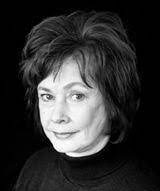

Sena Jeter Naslund: My mother, Flora Lee Sims Jeter, born in 1901, and I, an early teen, lounge on the summer bedspread as the attic fan draws in cool (for Birmingham) night breezes; we’re reading our separate books (Dickens, David Copperield for me, again), she chuckles, and I ask her, “What’s so funny?”
And she answers, “Virginia Woolf.”
I hold out my hand, and she hands me the book, Orlando. I read a bit: hmmmm. I hand it back, without even a smile, and burrow back into Dickens.
Now I’m a senior in high school, and the ballet-dancer high-school friend James tells me he’s reading Virginia Woolf, The Waves, and it’s beautiful, he says. Turns out my mother is also reading The Waves, from the library. “It’s beautiful,” she says. I try it.
It makes me angry: it is NOT beautiful; it tries to be beautiful; but it doesn’t make it: it is a failed attempt at achieving something like poetry: I can’t even keep the characters straight, they sound so much alike.
In graduate school, at the University of Iowa where I am a fiction-writing student in the Writer’s Workshop, and in a Ph.D. literature seminar on Bloomsbury writers, in the first session, I dodge Woolf to some extent by choosing to give my seminar paper on E.M. Forster’s A Passage to India. I’m afraid of Virginia Woolf.
But I read her novels and join discussions, and her Mrs. Dalloway and To the Lighthouse liberate me from the Victorian novel.
I see one can write a novel with virtually no plot; a novel that catches, perhaps, more authentic aspects of life: like Mrs. Dalloway. How we live, moment by moment, that can be the stuff of fiction. Our little days do matter; they are the stuff of life. That’s not all.
In my psyche, Mrs. Dalloway has an ending-note of pure magic. Woolf has a character turn to Mrs. Dalloway, the last sentence before the blank space of the book’s end being: “For there she was.” Well. There she was for me. I had identified with the point of view of the character, so that when he turned to see her, whom he knew well and loved, I turned with him. And saw her.
Not the blank space that signals the end of a book. “For here she was.”
I am astonished. There are no further words, and yet I see. She, Woolf, makes me see without words.
(Yes, as a writer myself, of course, I’ve analyzed how that effect was achieved.)
But when I read Lighthouse, the earth moves. It’s mid-book, and the main character dies! How is that possible in Fiction? I am deeply shocked. For me, the narrative form of fiction opens into a larger darkness. The ground under my feet disappears. What to do with this new knowledge about fictive form? As a would-be writer, I feel both unbound and tossed into the sea.
* * *
Flora K. Schildknecht: Death, parties, marriage, experimentation, time. I’m thirty-seven years old, wrapped in a down blanket on a chilly Kentucky evening, and these are the words I find, on a piece of hotel stationary, tucked inside an aging copy of Mrs. Dalloway and written in my mother’s looping, forward-leaning hand. These are not, by far, the only notes in the book—there’s a handwritten index of these and other topics (women and men, love of life) and copious margin notes. I ponder: Perhaps it’s finally time to read Virginia Woolf.
It’s not that I don’t respect Woolf—but her literary ghost has loomed large, and, in rebellion, I’ve avoided her. For years. Would I read a friend’s decidedly, delightfully queer, original novel, Mr. Dalloway? Of course! Would I watch Tilda Swinton in a sci-fi, art-house cinema version of Orlando? With delight! But I’d imagined that all there was to be said about Woolf had been said—what need could there be for me to read her? I was wrong.
Now a few days have gone by, and I’ve devoured Mrs. Dalloway, its pages brittle and showing signs of age, their contents anything but. I’m on a run through a park with oak, sycamore, and bramble alongside the paved path, and the waving of each leaf, the caw and trill of each bird, even the slap of shoe on wet pavement seems worth recognizing—worth living—in light of how Woolf writes of thought and of the sensual, experiential life.
I push to the top of the hill, and then down, the walloping impact of each footfall rolling through my gut. Is this what it means, to “look life full in the face?” I’m still reeling from reading Mrs. D: Wolf’s characters have been made real for me (by their immersion in the sensual world, their candid, often unlovely thoughts) to such a degree that I feel their consciousness. As a reader, it’s pure magic, as a writer, it’s a revelation—a call to reach for the limits of what one thinks prose can accomplish in terms of aestheticizing human subjectivity—and then reach farther.
Now I read my mother’s copy of To The Lighthouse. To my delight, my mother’s thoughts often align with my own (yes, I agree, Mr. Ramsey, in his insatiable need for sympathy is rather comic). Like Mrs. D, this volume is heavily annotated, different colors of pen and pencil pointing to multiple readings. And what I find is that these characters, Lily Briscoe and old Mr. Carmichael, Mr. Ramsey and Mrs. Ramsey and all her children, are not alone in the pages—my mother is here, too. Our shared appreciation of Lighthouse creates a bridge in time and space.
Such bridges matter since, reading, and writing, for that matter, are often solitary pursuits. Sometimes as a writer—particularly as the artistic achievements of women are slow to be recognized or ignored—one can feel some of the discouragement Lily Briscoe feels, as the world and those in it constantly admonish her that “women can’t paint.” So, I read again to one of my mother’s final notes in Lighthouse, one that could be directed to Lily Briscoe, or to me: Turn to the consolation of art. And although I’m alone, by the magic of the written language, there she is, my mother, saying the words.
* * *
Best known for her critically-acclaimed, best-selling novel Ahab’s Wife, a finalist for the Orange Prize, Sena Jeter Naslund is the author of nine works of fiction, the most recent being The Fountain of St. James Court or Portrait of the Artist as an Old Woman. Her books have been translated into Spanish, German, Danish, Polish, Greek, Hebrew, Japanese. She is working now on a historical novel titled Before the War, about the childhood and early adulthoods of Frederick and Anna Douglass, Abraham and Mary Lincoln, and Jefferson and Varina Davis.
Flora K. Schildknecht is the author of Megafauna: Stories and Screenplay. Her short fiction has appeared in various journals and has been twice nominated for a Pushcart Prize. She serves as Associate Editor of The Louisville Review, and she has served since 2016 as a part-time instructor for the English department at Bellarmine University where she taught courses in creative writing including Fiction, Creative Nonfiction, and Playwriting. She received an MFA from Spalding University, where she studied fiction and dramatic writing, and she is currently pursuing a PhD in Comparative Humanities at the University of Louisville.
Now I have to go grab my copy and reread, love this and I hope my kids enjoy my margins one day!
This is great. One candle lights another.
A very special communication that will be able to span generations. We frequently live distant lives. Our thoughts remain our own isolated thoughts. This gives a new light on how life threads a needle of connection. I loved this. Thanks much!